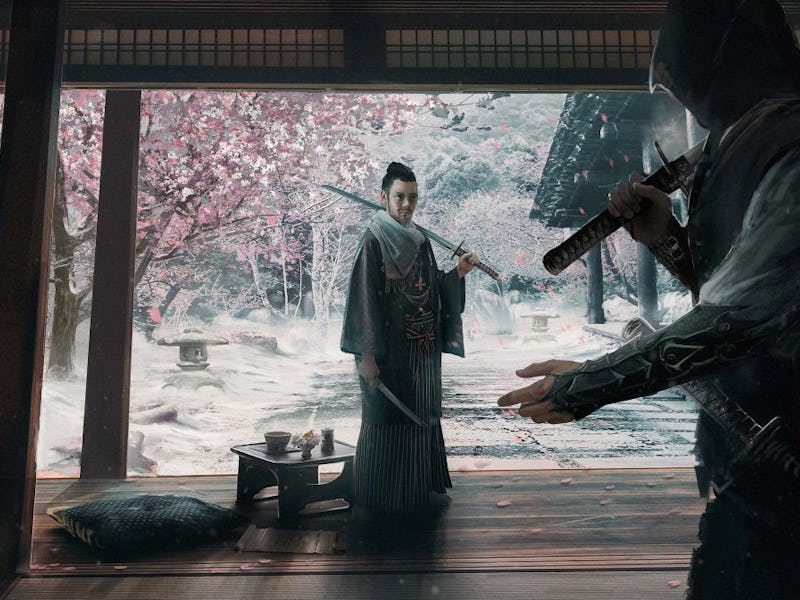The Next 'Assassin's Creed' Game Should Be Set in Japan
During the Satsuma Rebellion; the fall of the samurai.

With 2016 coming to a close, Assassin’s Creed Syndicate’s time to shine is starting to fade - and if Ubisoft’s previous yearly Assassin’s Creed release schedule is to be followed? It’s time for us to start thinking about the next location we will be setting foot in to come 2016.
As a franchise, Assassin’s Creed has taken us across a wide variety of territory in the last eight years, plunging us into the Assassin vs. Templar conflict in places like 12th century Jerusalem and 19th century London. We’ve fought through the Holy Crusades, the Italian Renaissance and even the Golden Age of Piracy — but what’s next for the historically-themed franchise?
It could very well be Japan.
A theory posted earlier this year by Cornik22 on the Ubisoft forums raised a few eyebrows, especially after the confirmation of Syndicate being set in London earlier this year. Essentially, Cornik was claiming that Ubisoft gave us the location of the next three Assassin’s Creed games back in 2013 — all within a piece of concept art released in The Art of Assassin’s Creed IV: Black Flag.
You’ll notice that in the piece by Ubisoft artist Martin Deschambault there’s a flat screen behind the lobby desk. On this flat screen are six images, each showing a landmark that references previous games including the original Assassin’s Creed, AC2, AC: Black Flag, AC: Unity and the most recent installment, AC: Syndicate — but the last image? It’s a Japanese temple surrounded by houses, which Cornik guessed was Sensoji Temple, Tokyo’s oldest and most significant one.
Earlier this year, people seemed to doubt Cornik’s hypothesis, but with the image confirming the last two games in the franchise, it’s hard to skim over the idea that he might just be right.
And if he is? Ubisoft should place the next game around the time of the Satsuma Rebellion.
Taking place in 1877, the Satsuma Rebellion was the ‘final’ revolt of the samurai against the new imperial government nine years into the Meiji Era — namely due to the abolition of the privileged social status the samurai had, as well as undermining their financial position within the country. Leading up to this abolition, a series of edicts were also issued that prohibited individuals from dressing like samurai, carrying their weapons in public and having top-knots in their hair.
Unsatisfied with these changes and fearing political corruption, one of the senior leaders in the Meiji government, Saigō Takamori, broke off and formed a private academy to help support his fellow ex-samurai. The decision led to a conflict that would last for years, ending in 1877 when the last 40 of his followers would be taken out by the Imperial Army.
Ubisoft could do a lot with a historical setting like this because of the nature the conflict was centered around: modern vs. feudal. In many ways, it represents the same sort of approach they took with Syndicate’s plot, where Jacob and Evie Frye fought against enemy Templars who were using practices such as child labor to further their cause during the modernization of England.
Players could take on the role of a new samurai, training under Takamori (who would be an assassin, of course) at one of his academies, learning the art of Bushidō and rising through the ranks of the Assassin Brotherhood. Throughout the game, players could also be taking place in battles like Connor did during the American Revolution in Assassin’s Creed 3; fighting with samurai against the Imperial Army during historical events like the Siege of Kumamoto Castle, the Battle of Tabaruzaka and the final fight during the Battle of Shiroyama, assassinating Templar leaders and securing resources for the samurai rebellion along the way.
Naturally, players would also have access to a wide-variety of weaponry used by the samurai, including the traditional samurai blades such as the katana, wakizashi, and tachi. Ubisoft could also bring back the bow from Assassin’s Creed 3, although that’s just a personal favorite, as well as include firearms once again due to the nature of the conflict and modernization of Japan’s military.
Plus, we’d be able to get a look into Japanese culture with beautiful temples, colorful garments, and eastern-styled architecture. Sounds pretty cool right?
Honestly, an Assassin’s Creed game set in Japan could truly be the breath of fresh air gamers have been looking for in the franchise - namely because of an entirely different location and culture that isn’t focused on the western world we’ve seen in most AC titles to-date. Sure, we got to see the 2.5D world of China through Assassin’s Creed Chronicles this year — but it just isn’t the same as seeing the beauty of the eastern world fully visualized.
Here’s to hoping that change comes in 2016 with the next installment of Assassin’s Creed. I mean, hey, if Ubisoft has already put samurai into their title For Honor next year, how could they resist doing the same for one of their biggest franchises?